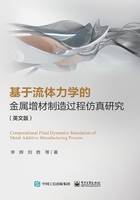
Preface
Additive Manufacturing (AM) process is a widely used technology for the design and production of high-performance components. The layers designed by computer are gradually added to construct 3D parts in AM process. This unique process can be used to manufacture complex or customized parts.
The metal additive manufacturing process is studied in this book. The fluid problem in the metal additive manufacturing process is investigated based on the Computational Fluid Dynamics (CFD) method. Chapter 1 is the introduction.Chapters 2 to 4 study the internal flow field and spatter particles' tracks in the metal additive manufacturing printer,and design an innovative fluid cover to optimize the internal flow field of the printer and employ a negative pressure tube to remove spatter particles. Chapters 5 to 9 mainly study the characteristics of the molten pool in the metal additive manufacturing process. Chapter 5 studies the dynamic characteristics of the molten pool. Chapter 6 studies the effect of the external magnetic field on the molten pool and the solidification process in additive manufacturing process. Chapter 7 and Chapter 8 study the evolution processes of single pore defects and multi-pores defects inside the workpiece in the metal additive manufacturing process. Chapter 9 studies the laser polishing processes of metal additive manufacturing workpieces to control the surface roughness.
Mr. Jiayue Wang for Chapter 2,Mr. Liang Zhao for Chapter 3,Mr. Lei Wang for Chapter 4,Mr. Tao Zhang for Chapter 5,Mr. Liwei Chen for Chapter 6,Mr.Bingnan Shen for Chapter 7,Mr. Leilei Shi for Chapter 8,Mr. Dongqi Zhang for Chapter 9,Mr. Jiantao Zhou is responsible for the organization and verification of the book. Professor Hui Li and Sheng Liu contribute to the numerical simulation and experimental method.
This work was supported by the National Key Research and Development Program of China(2017YFB1103900);the Key-Area Research and Development Program of Guangdong Province(2018B090905001);the Natural Science Foundation of Guangdong Province(2018A030313044);the Science and Technology Program of Shenzhen(JCYJ20170816171733384).